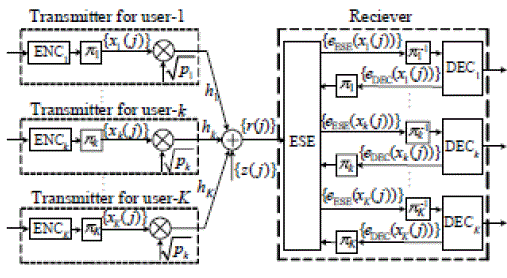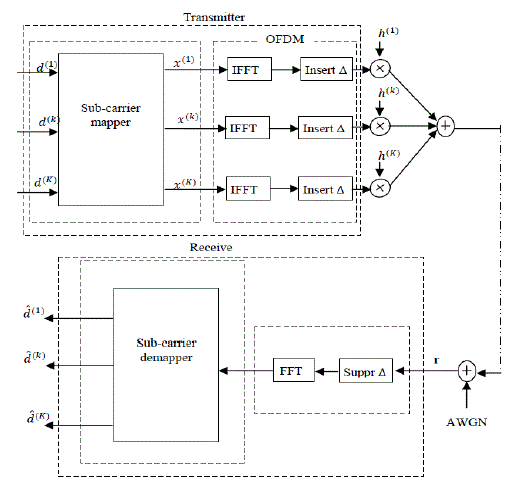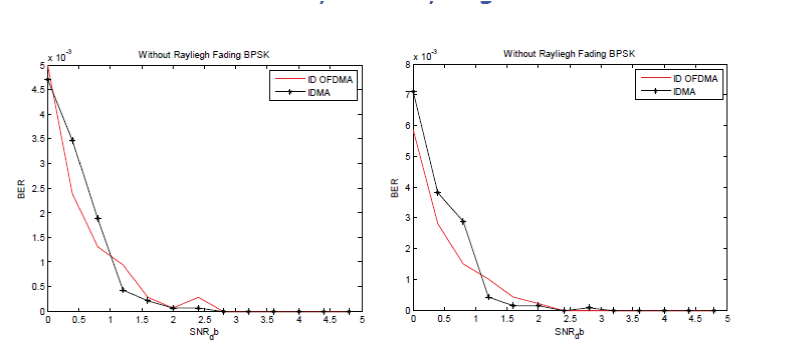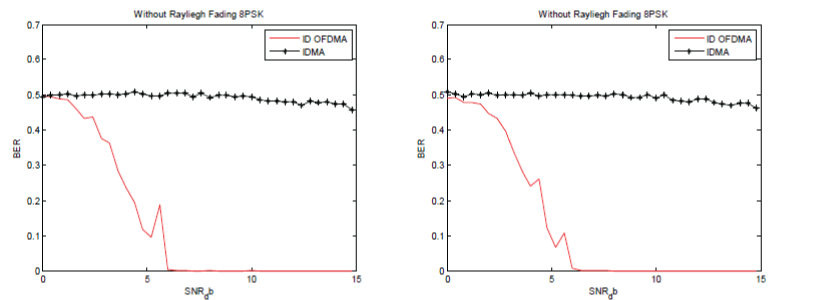Keywords
|
| OFDMA, IDMA, quality of service, WLAN, 2G/3G cellular communication |
INTRODUCTION
|
| Development in wireless communication has changed modern world. Two decades before only high-tech notebooks had connectivity capability with Wireless Local Area Networks (WLAN), for wireless broadband internet access. But now WLAN connectivity is common to many modern communication devices due to increasing consumer demand. This growth has offered new application like multimedia streaming and video-on-demand. This development has created a innovative research field for “wireless broadband access everywhere”. Mobile environment also providing services of internet surfing or watching a video stream it indicates the success of wireless broadband by means of WLAN. |
| Current 2G cellular technologies like (GSM) are designed for voice-centric network but they work poorly for databased applications. The 3G cellular technology like UMTS and HSDPA are better suited for data-centric based network transmission. But these standards are not able to provide the demand of high data rates and high expectations of quality of service (QoS) for future prospects |
| Future systems are designed in respect of fields that gives high capacity. It has been found that [1, 2] interleave division multiple access (IDMA) systems provides capacity of higher information transfer over orthogonal frequency division multiplexing (OFDM). Two major disabilities multiple access interference(MAI) and inter-symbol interference (ISI) are present in wireless communication systems that can degrade transmission performance. Many proposed techniques like time domain equalization are available but they are very costly, OFDM can fight with ISI very efficiently with methodology of conversion by using the frequency selective channel into parallel flat fading channels. The benefits of IDMA [3] are over minimizing MAI by iterative process of combining elementary signal and decoding. In next section we will discuss about both technologies in details and final we will determine the effect of an IDMA-OFDMA system on performance of bit error rate (BER) with respect to change in SNR |
II. IDMA AND CHANNEL INTERSYMBOL
|
| Inter Symbol Random interleaving facilitates detection in ISI channels [11] and minimizing MAI both. The workings of IDMA Technology in wireless communication are discussed below |
| 1BASICIDMASYSTEM |
| For anIDMA system in presence of ISI channel, the modified model of a received signal is given by equation (1): |
 |
| r: received signal vector, |
| hk:{hk,0, …, hk,L−1} a fading coefficients vector for user k, |
| xk: the transmitted signal vector for user k, |
| z: sample vector of AWGN noise and |
| ⊗: represents convolution operation. |
| Let we consider the transmitter for user k, at start the information encoded by ENCk (encoder) see figure 1 and then passed by an interleaver πk into a chip sequence {xk(j)}. In some cases a power control factor pk is also used. The conventional spreading operation in CDMA is used but it is not necessary because user separation is also performed by user-specific interleavers {πk}. |
| Focusing the kthuser the equation (1) is written as: |
 |
| whereξk(j) is the noise-plus-interference component in r(j) with respect to xk(j). Although the above detection technique is rather simple and straightforward, it works very well, usually converging to satisfactory results within several iterations. |
III. OFDMA TRANSMISSION SYSTEM
|
| In OFDMA the transmitted signal is taken as sum of equal bandwidth but independent Nc sub-symbols having frequency separation 1/Ts , (Ts : OFDMA symbol time duration). Since all K sub carriers are used to carry data for one user. In case of multiple users want to transmit using OFDM, they have to take their turns in time [4]. The OFDMA transmission system of OFDMA is shown in Figure. 2. |
| Here one sub-carrier is assigned per user and additive white Gaussian noise (AWGN) is acting as source of disturbance , the nth of encoded bits is mapped into the complex valued OFDMA vector [5] of QPSK constellation points, and thereafter single multi carrier symbol in the continuous time representation is given as: |
 |
| Where m is a symbol index and Xk(m) is the QPSK value of kth user with K= 0, 1, . . . , K- 1, at the receiver, here the all users channels to the base station are constant for every OFDMA symbol. |
| The demodulated receive signal is written below: |
 |
IV. OFDMA IDMA
|
| Multiple-access interference (MAI) and inter-symbolinterference (ISI) cause degrading quality inwireless communication. Conventional methods are very costly and recently it has been shown that interference can be minimized by an orthogonal frequencydivisionmultiplexing interleave-division multiple-access (OFDM-IDMA) scheme [6–8]. In this paper we have minimize ISI by the cyclic prefixing technique in OFDM [9],by iterative detection with IDMA [10]. Comparedwith conventional multi-carrier schemes, OFDM-IDMAhas several noticeable advantages such as low-cost receiver,diversity against fading and flexible rate adaptation. |
| The results consist of the analysis and design for OFDM-IDMA. We show that OFDMA IDMA schemes can achieve significant performance improvement over orthogonal schemes. This provides a motivation for optimising the performance of OFDM-IDMA systems according to theoretical prediction. |
V. RESULTS AND DISCUSSION
|
| We have used Matlab10 based platform for writing algorithm.We have written script file for wireless transmission in AWGN noise at different SNR |
| We applied first IDMA on our message signal and checked BER at SNR values varying from 0 to 5. Figure 3 (a & b) are BER vs SNR plot for BPSK modulation solid line for IDMA and dashed line for IDMA-OFDMA transmission. We can see that the BER for OFDMA-IDMA transmission is lower than IDMA. 3(a) and 3(b) are results obtained for two different random messages. |
| Similar algorithm is applied for QPSK modulation. Figure 4(a & b) are obtained again for two different random signals and we an again see that The BER for OFDMA-IDMA (dashed) is obtained lower than IDMA only(solid). |
| Prior to interleaving we have applied conventional coding.For BPSK the polly to trellis structure used is (5,[23,35,32,31])for generating polynomial and for QPSK it is ([5 4],[23 35 32 31; 17 14 5 13]) about 1384 binary message signals are generated different time for testing the algorithm. |
| Similar algorithm is applied for 8PSK modulation. Figure 5 (a & b) are obtained again for two different random signals and we can see that The BER for OFDMA-IDMA (dashed) is obtained lower than IDMA only (solid). |
| We have considered three case for each case the maximum value of BER obtained is given in table 1. |
| Table 1 represents that BER is minimum in case of BPSK and as the M-array number is increased BER is increasing |
VI. CONCLUSION
|
| We have designed an IDMA-OFDMA system to check its performance and robustness against the AWGN noise. Three different schemes are used for modulation known as BPSK; QPSK and 8PSK the BER values are calculated by using Matlab based simulation algorithm. It has been found that for different random generation of binary signals we get lower BER in the case of OFDMA –IDMA system. Hence IDMA system alone can perform good performance against multiuser access interference but along with OFDMA IDMA we can combat with ISI and get reduced bit error rate. At higher SNR performance of both IDMA and IDMA-OFDMA become equivalent but at lower SNR OFDMA-IDMA helps in lower the BER. For different modulation the lowest BER is obtained for BPSK in the range of 5 x10-3 to 7x10-3 hence the performance is best for BPSK. But in the case of 8PSK our IDMA-OFDMA outperforms to IDMA . |
Tables at a glance
|
 |
| Table 1 |
|
Figures at a glance
|
 |
 |
 |
 |
 |
| Figure 1 |
Figure 2 |
Figure 3 |
Figure 4 |
Figure 5 |
|
| |
References
|
- M. Mahafeno, C. Langlais, and C. Jego, “Ofdm-idma versus idma with isi cancellation for quasistaticrayleigh fading multipath channels,” Turbo CodesRelated Topics; 6th International ITG-Conference on Source and Channel Coding (TURBOCODING), 2006 4th International Symposium on, pp. 1 -6, april2006.
- L. Ping, Q. Guo, and J. Tong, “The ofdm-idma approach to wireless communication systems,” Wireless Communications, IEEE, vol. 14, no. 3, pp. 18 -24,June 2007.
- P. Hammarberg, F. Rusek, O. Edfors, “Channel Estimation Algorithms for OFDMIDMA: Complexity and Performance,” Wireless Communications, IEEETransactions on, vol.11, no.5, pp.1722-1732, May 2012.
- H.Li and H.Liu, “An Analysis on Uplink OFDMA Optimality,” Vehicular Technology Conference, 2006. VTC 2006-Spring. IEEE 63rd , vol.3, no.,pp.1339-1343, 7-10 May 2006.
- M.Deumal, Multicarrier communications systems with low sensitivity to nonlinear amplification, PhD thesis, Ramon Llulluniversity, Barcelona, 2008.
- Mahafeno I, Langlais C, Jego C. OFDM-IDMA versus IDMA with ISI cancellation for quasi-static Rayleigh fading multipath channels. In Proceedings ofthe 4th International Symposium on Turbo Codes and Related Topics, Munich, Germany, 3–7 April 2006.
- Schoeneich H, Hoeher PA. Adaptive interleave-division multiple access-a potential air interference for 4G bearer services and wireless LANs. InProceedings of 1st IEEE and IFIP International Conference on Wireless and Optical Communications and Networks (WOCN 2004), Muscat, Oman, June 2004,pp. 179–182.
- Li P, Guo Q, Tong J. The OFDM-IDMA approach to wireless communication systems. IEEE Wireless Communications Magazine 2007; 14(3):18–24.
- Fazel K, Kaiser S. Multi-Carrier and Spread Spectrum Systems. John Wiley Sons: Chichester, UK, 2003.
- Liu LH, Tong J, Li P. Analysis and optimization of CDMA systems with chip-level interleavers. IEEE Journal on Selected Areas in Communications2006; 24(1):141–150.
- L. Liu, W. K. Leung, and Li Ping, “Simple chip-by-chip multiuser detection for CDMA systems,” in Proc. IEEE VTC’2003- Spring, Jeju, Korea, Apr.2003, pp. 2157-2161.
|